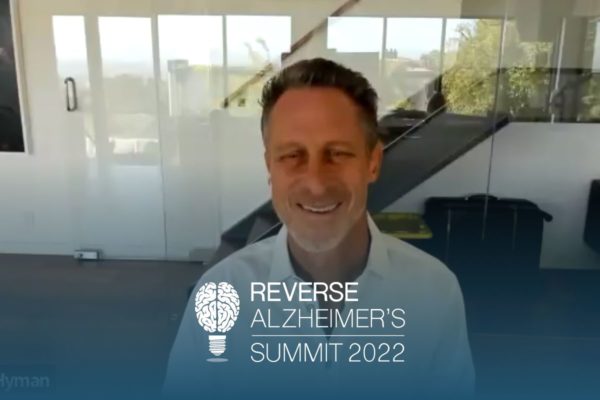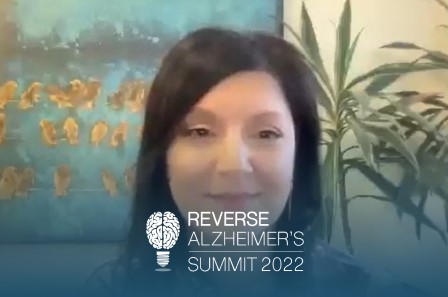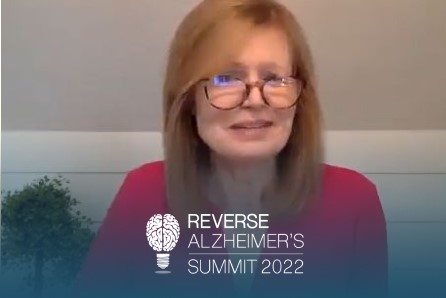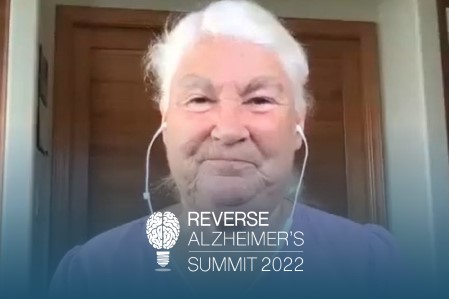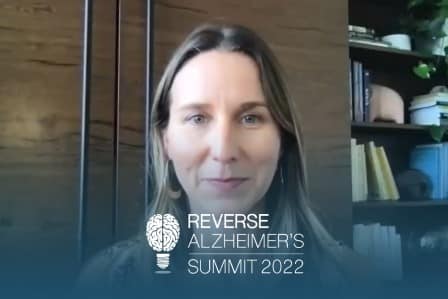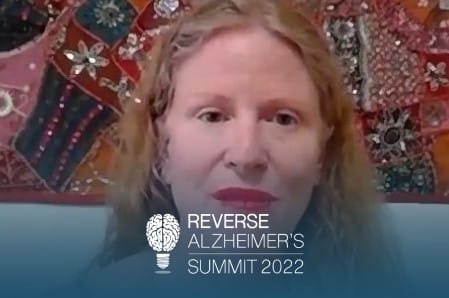Join the discussion below

Dr. Bredesen earned his MD from Duke University Medical Center and served as Chief Resident in Neurology at the University of California, San Francisco (UCSF) before joining Nobel laureate Stanley Prusiner’s laboratory at UCSF as an NIH Postdoctoral Fellow. He held faculty positions at UCSF, UCLA and the University of... Read More
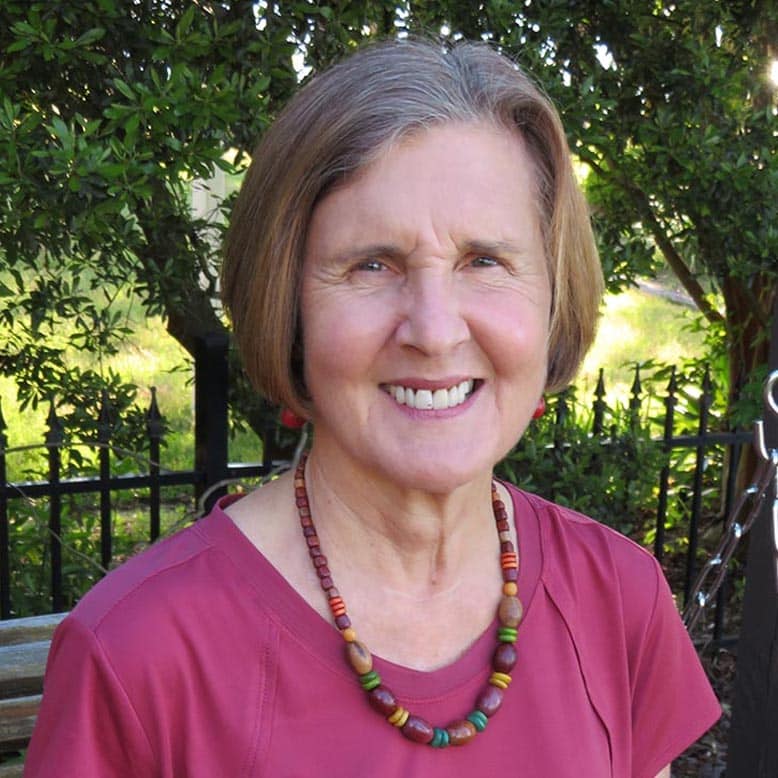
Dr. Sally Weinrich (pronounced Wine-rick) is one of the seven First Survivors of Alzheimer’s presented in Dr. Bredesen’s 2021 book. She retired in 2008, from her professional career as a doctorally-prepared research nurse. Dr. Weinrich completed her first cognoscopy July, 2016, and is now in her sixth year of adherence... Read More
- Diagnosis of Alzheimer’s
- Cognoscopies
- Challenges
- Benefits
- Message for Listeners
Dale Bredesen, M.D.
Hi, everybody. Welcome again to the Reverse Alzheimer’s Summit. I’m here with Dr. Sally Weinrich, such a pleasure to have you here today, Sally, thanks so much for joining us.
Dr. Sally Weinrich
Thank you.
Dale Bredesen, M.D.
And just a little background, Dr. Sally Weinrich has a PhD in educational research. She worked and she was both nationally and internationally recognized for her work on prostate cancer screening. And she taught for many years that Alzheimer’s is untreatable as part of her nursing teaching. And she is in the first survivor’s book. And I think a wonderful example, on numerous levels, and we’ll go into those. So I thought it would be very illustrative to talk to someone who’s actually been through this and really done a spectacular job. So Sally, maybe you could start just by telling us what were your early symptoms, some of the things that bothered you at the beginning?
Dr. Sally Weinrich
I had read a lot on “Normal age and changes.” And I had all those, but I had ’em to a greater intensity and degree. And it did a lot of embarrassing things. Like I would get to my doctor’s office, and would remember at that time I did not have my pocketbook and therefore I did not have my insurance cards. Or I would get to the gas station and to gas, need my credit card to pay for my gas and not have a credit card. And so I had a lot of forgetful things I did that I hadn’t done before that definitely interfered with day-to-day living. I was starting to have trouble even deciding what to wear. It took me three times as long, and I was constantly running late. And one day I looked at a clock and after I asked, I don’t remember how it came up, but I could not remember how to draw the second hand. I did not know whether the hour hand or the second hand, I did not know which was which. And then I denied it or didn’t want to think about it ’cause I didn’t think there was any treatment for it like most people do, or many people do. And then I forgot to pick three grandchildren up to take ’em to school one day. And then I forgot again within the same month. And I would never forget to pick my grandchildren up to school, they were apple in my eye. And that was when I said, “Forget the denial Sally, you’ve got Alzheimer’s.”
Dale Bredesen, M.D.
And you know, I should just to point out here why you’re telling your story, that one of the common criticisms that many people receive who we claim that we’re reversing cognitive decline, people say, “Well, this person really didn’t have any evidence of Alzheimer’s you’re just assuming that.” Well, in your case, you had everything. So you had APOE4 positive. So you had a single copy associated with Alzheimer’s. You had a PET scan that was amyloid positive, so again, showing that very clearly you had Alzheimer’s disease. You had a MoCA score of 24.5, which is typically considered MCI. But for someone who has a doctorate and is working in a school training, and this is really what I would call late-stage MCI, you had both the kind of typical parietal symptoms with trouble with the clock, and trouble with spatial issues, and also the amnestic issues with trouble picking up your granddaughter. So you really had the typical, the APOE4 is typically associated with the amnestic side and the toxicity which you turned out to have of course, is typically associated with the non-amnestic sort of presentation. And you clearly showed both of those. And then you had one other thing we’ve seen a number of times, you actually got worse with the anti-amyloid antibodies. So if you could continue that and talk a little bit about how you got into the trial and your response to being treated with an anti-amyloid antibody.
Dr. Sally Weinrich
I retired from research in 2008, and as a funded researcher, I believe strongly in research. And so I actively sought out research studies to deal with my Alzheimer’s, which I thought felt like I had. And I was hoping I was at the prevented stage at that time. And so I heard about this national study that started, I enrolled in 2015, the cohort that I enrolled in actually started in 2014. And it was recruiting non-symptomatic or mild symptomatic patients or people in the community nationwide who were positive beta amyloid plaques. And I did not know whether I was randomized to the placebo or control, but before I started the study, I did the mild cognitive experiment so I can know what my score was. Montreal Cognitive Assessment. And then I also did the subtracting seven from 100 as my way of measuring roughly how my cognition was doing. And each month I got worse and worse. And starting the third month, I started getting headaches, irritability, anxiety, which I had never had before and really didn’t know how to handle, and my ability to remember, and my forgetting things increased significantly in severity. So after eight months I asked to withdraw, the trial encouraged me to take a break, which I did for three months, and then after think about even more, I withdrew from the study.
Dale Bredesen, M.D.
Yeah. And I think it’s certainly lucky you did. One of the other people that we dealt with years ago just continued. His wife said the doctors know what they’re doing, so it’s okay if he gets worse. And he went from a 22 to a six over 18 months. So it’s tough. And of course it’s impossible to know colossality, but the temporal association is often striking. So it’s a good thing that you got out of that when you did. And then where did you go from there?
Dr. Sally Weinrich
My husband heard about you on a talk show, “People Pharmacy.” December of 2015, you were my nice Christmas present that year. And I called you wanting to be enrolled in your research study, and you did, which is understandable, the RRB would not allow out-of-state enrollees. But you agreed to work with me and my physician. And through a joint telephone call with my physician, I then ended up completing the cognoscopy, my first cognoscopy. I’ve had yearly cognoscopy since then. In July of 2016. And I had everything wrong. I was positive for five of the six different types of Alzheimer’s, and the one I was not positive for, which was vascular, I had problems with, in that my total cholesterol and triglycerides were record low. And you told me what a physician had never told me before, which was that I needed healthy fats in my brain for it to function well. I always before had been complimented heavily on my low cholesterol and low triglycerides. And the other thing I would add that is a little different answer, my answer to your original question of when did I first know? Around 2016, you came out with your publication describing type 3 inhalation toxins. And in that you described what had happened to me in year 2000. 16 years before that time when I had moved to a new place and attributed my depression to the move and to the pressure to do research in a research-driven university. And then I lived in a home with mold in the basement, and I also had the low zinc, although I didn’t know it at the time, I had the biomarkers of low zinc, low cholesterol, and there’re several others that I don’t remember but I’ll ask you to add now. So I realized-
Dale Bredesen, M.D.
You had low triglycerides And you had the TGF beta 1 that was quite high et cetera, et cetera, yeah. C4L that, yeah.
Dr. Sally Weinrich
So I realized in retrospect that my Alzheimer’s had really started in 2000. I just did not know it at the time.
Dale Bredesen, M.D.
Yeah, and again, this illustrates a very important point when people have looked longitudinally, you are really looking at about 20 years typically between the onset, the pathophysiological changes, and a diagnosis of Alzheimer’s, so it makes perfect sense, here you were having problems in 2011, you were already well into the MCI stage, and your problems really began symptomatically. So you really had SCI as early as 2000. And as the epidemiologists have shown us, SCI tends to last about 10 years, that fits with you very well. And then you went into MCI and you were fairly well along in MCI when you started getting on the program so you are now six years, and talk a little bit about first of all, what did you notice in terms of changes? Because another thing that we hear very frequently is, “Well, I’ve been on this for a couple of months and I’m not noticing huge improvements. I think I’m gonna look for something different.” But you’ve really stuck with it, and I think you’re a great example of someone who has really sustained. You’ve got your improvement and now you’re six years on and continuing. So talk about if you would, the first things that you noticed.
Dr. Sally Weinrich
In changes and improvements, is that correct?
Dale Bredesen, M.D.
Yes, yes.
Dr. Sally Weinrich
Okay. My research background kicked in and I immediately, the two things I started doing right away was sleep, more sleep and eating healthier. But I also started meditating every day and it was hard for me to sit down and do nothing to meditate. Although meditating is not doing nothing-
Dale Bredesen, M.D.
You’re not, yeah.
Dr. Sally Weinrich
It was not working based on that-
Dale Bredesen, M.D.
You’re an active person.
Dr. Sally Weinrich
Oral background, yeah. And so I did again, that subtracting seven from 100. And kept track of how fast I could, at that time I could not do it accurately. But I also kept track of the time. And after a month of meditating each morning, I started out, and the other thing I did in my lifestyle changes, I would start it slowly. So I started out meditating 15 minutes each morning, and then I increased it to 1/2 an hour. And after a month of that, I saw that I was one, subtracting seven from 100 correctly, and two, quicker. So I’ve encouraged everyone I’ve taught to identify something that they’re having problems with. A real quick, immediate one that I could easily remember and see the difference is I would go from start at say at the kitchen, go to the bedroom to get something and I’d get to the bedroom and forget what I was gonna get. That is a real common thing that I hear a lot of people talk about and that changed. I could remember what I went to get without having to go back to the kitchen or going back to the kitchen and not remembering it. But I think cognitive changes are, I’m real tuned in now. I still can relapse real easy. I recently had surgery and did real well with it. But I now have trouble recalling names. So for me, anytime I call my grandchildren by their wrong name, mix up, like one is named Brice, one is named Molly, and one’s named Emma.
If I call Emma Molly or the other way around, that’s my sign that I’m doing something wrong and I need to change it. So what I’d encourage people to do is keep, and thankfully I did keep electronic record of what I could and couldn’t do and the dates at which I did certain behavior. What I get the quickest changes for is my exercise. I increase my exercise. You recommend at least 30 minutes a day, five days a week, I had already been doing that and I increased it to hours. So I can see immediately daily changes in that. The other things that were really hard for me to do like following the dirty dozen and only eating the 12 foods that continue to be contaminated even after you wash ’em, that was hard for me to do. I still have trouble and struggle with ketosis, but I have given up my sugars and my carbohydrates. And when I am ketosis, my husband has real good metabolic flexibility and he can eat all kind of things, and the next day he would be ketosis.
Dale Bredesen, M.D.
Wow.
Dr. Sally Weinrich
And I can’t. But when I am, I can tell improvement in cognition.
Dale Bredesen, M.D.
Yeah. And many people say that, ketosis really is associated with an improvement in their cognition, and you brought up another good point, which is that everyone has some natural variability and it goes with how they’ve slept, how much stress they’re under, all these sorts of things, how much stimulation they’ve had, and we have one guy, brilliant physician, who loves to cheat and he loves to eat ice cream. And so what he’ll do is, he does the same thing he notices that you do, the first thing that he has is a little bit of trouble with naming. And so he’ll just fix it, so he cheats no more than what gives him a little trouble with naming then he can do everything else just fine. Of course we’d like him to quit doing that and do even better, but he does very, very well with that degree of cheating. So there is this variability, and we wanna go, on the other hand, we wanna go saw-toothing up instead of saw-toothing down that’s the key. And you mentioned earlier that people told you you had a good cholesterol, so you had a triglyceride of 29. So of course, that looks very good when you say, “Oh, does this person have vascular disease?” But it’s one of the kickoffs, is one of the hints that, “Oh my gosh, this person might actually have a toxin associated Alzheimer’s disease.” And so if you could talk a little bit about what you have done to address the toxicity. Have you been on the Shoemaker protocol or a variation thereof, and what sorts of things have you done?
Dr. Sally Weinrich
And I’ll start off by saying in your previous talks and in your book, you talk about type 3 or the toxicity being the hardest form of Alzheimer’s or type of Alzheimer’s to deal with. And I have lived that, I agree with that 100%. And in fact, I’m still dealing with it and I’ve decided I’ll probably have to deal with it for a lifetime. And my Christmas present this year that I will be getting in July is a sauna to deal with the toxicity.
Dale Bredesen, M.D.
Ah, fantastic.
Dr. Sally Weinrich
But I started out taking the lovely cholestyramine and I did follow the Shoemaker protocol, and I found a physician who was trained in the Shoemaker protocol in South Carolina by looking online. And I started out with the lovely a lovely cholestyramine and then went through the 13 different steps in the Shoemaker protocol for treatment. A lot of what I’ve done has been expensive unfortunately, and the most extensive supplement I took with VIP, for vaso intestinal peptide I think, is the correct. And I can look up and give you, I’ll email you later if it’s different date, but I think I took that let’s say 15 months and I stopped it not because it wasn’t working, it worked great, but because of the cost.
Dale Bredesen, M.D.
Sure.
Dr. Sally Weinrich
And my blood values, my TGF beta and the C4A were normal as long as I was taking it. But once I stopped, they increased in value again, it became abnormal. And I now am following partly the Dr. Nathan protocol, and am doing the, it’s called something plains test wipe.
Dale Bredesen, M.D.
Great Plain Lab, the GPL, yeah.
Dr. Sally Weinrich
Yeah. Great Plains test. And the first time I was toxic on four different toxicities, the last one, one had been corrected, but I still am positive for the Aspergillus and one more.
Dale Bredesen, M.D.
Right, and
Dr. Sally Weinrich
Even though I’ve been taking GI Detox and activated charcoal. And then the other thing in your treatment, under the Shoemaker protocol, when you’re under treatment, your symptoms increase in severity. And so anytime I would go into other indoors, which hadn’t been mold remediated, my home had to be mold-remediated, my home was positive, and had to do all the mold-remediation part of it, even though it was a relatively new home at that time, we had built it, it was only eight years old. So I was safe in my home, but I wasn’t safe in any other indoors. And I would react with symptoms of CIRS, Chronic Inflammation Response Syndrome. Depression and anxiety were the worst symptoms, but I also would have vertigo, I couldn’t walk straight. And I would have insomnia after exposure. I would have four or five other symptoms that I can’t remember right now, but it was not fun to go into other indoor environments. So basically I was home-bound. I could go outside, outdoors, I’d do great. I was home-bound for over two years. Once I got the IV glutathione and four other substance including vitamin B12, and sodium bitartrate. Got better, and now I can go into limited other indoors. Usually if it’s older building, I will react negatively to it. But the good part is my reaction now is that, oh, and cognitive thinking, and what’s called brain fog in CIRS, I would have with every exposure. Now my first symptoms I have from exposure to other indoors that are contaminated is brain fog. I have trouble with names I don’t get depressed or anxious, which is really nice.
Dale Bredesen, M.D.
Yeah. Fantastic. And I should point out to everyone, your MoCA score went from 24 1/2 to 30, and now you repeated testing, you get 30 or 29 every time, both perfectly normal. So that’s fantastic. And you know, again, if you go by the statistics, someone who began symptoms, which would really be the beginning of SCI in 2000, 22 years later, would likely be in a nursing home or would’ve passed away, and you are doing absolutely great. So if you maybe talk a little bit about some of the things you do each day, I know you’re a kayaker, and you’re a swimmer, and you enjoy all sorts of things, you going places and doing things with your husband, and getting out there. You live in a beautiful area in South Carolina. And talk a little bit about what you’re doing on a day-to-day basis if you would.
Dr. Sally Weinrich
And before I do, let me comment about one other thing I did on toxicity that I think you probably won’t include, but for some people, it would be relevant. I still sleep outdoors in a-
Dale Bredesen, M.D.
Oh, wow.
Dr. Sally Weinrich
And when I sleep indoors, I can now sleep, but it’s not a deep sleep. It’s the sleep that you look at the clock, you feel like you haven’t slept, but you look at the clock and the hours go by. And I’ll wake up either four or five times at night. If I sleep outside, I sleep like a baby. I’ll wake up once to go to the bathroom and that’s it.
Dale Bredesen, M.D.
Yeah, yeah.
Dr. Sally Weinrich
And I’m in deep sleep that I really wake rested. So for someone who’s like me, in my mind, I had that mold exposure and I didn’t start treatment until 16, 17 years later. Who’s very contaminated like I was from toxicity, sleeping outside might be the answer.
Dale Bredesen, M.D.
This is a really good point, yeah.
Dr. Sally Weinrich
And then now what I do on a daily basis, I wake up and usually I’ll wake up slowly and wake up with some form of meditation. I’m a Christian, so for me it’s spiritual. But I think any form of meditation when you’re waking up and the sunlight, you have that golden glow, and you’re kinda half awake and half asleep, it’s like your senses are at a greater alertness. And meditation is just fun at that stage. I don’t usually eat until about 10:00 am because of the KetoFLEX 12/3 diet. And since I am positive for APOE4, I do the fasting 15 hours and usually 16 hours between dinner and breakfast.
Dale Bredesen, M.D.
Got it.
Dr. Sally Weinrich
And then I’ll do whatever I want in the morning before breakfast, it might be exercise, it’s usually meditation. I have to work on my meditation, I have a tendency if I’ve traveled, like my husband and I recently did this last week to Myrtle Beach, I get back home and I don’t want to do meditation. but ideally, I’ll meditate in the morning, I very often would do some form of exercise, I do Pilates and yoga, and I have a bicycle I use at home. With summer coming, very often I’ll get out and kayak at eight before the winds blow up on the lake. We do that two or three times a week. And then also in the summer I swim two or three times a week. And for the last three years, I have swam 1.7 miles at dam. And it’s mainly high school swimmers who swim it.
Dale Bredesen, M.D.
Wow.
Dr. Sally Weinrich
And I was the oldest one this last year, but I came in last, but at least I finished.
Dale Bredesen, M.D.
That’s amazing, to swim 1.7 miles. Wow, fantastic.
Dr. Sally Weinrich
And then often I’ll swim in the lake out in front of me and I have a little buoy so that I kinda let people know I’m around. So very often I’ll do some form of meditation and exercise in the morning. Then I’ll either have breakfast by myself ’cause my husband’s gone out or he and I will have time together, and that’s a fun social time. And when I was home-bound with my CIRS, Chronic Inflammatory Response Syndrome, I usually would have someone I would call every day and talk by phone. I talk to my sister every day now, but I would have different friends I would call either weekly or monthly for my socialization. And I think socialization’s an important part of cognition. And then I don’t know what I do with the rest of the day, but I’ll tell you some of the things I do because I don’t have enough time to get everything done.
I do spend a lot of time on cognition, whether it’s doing my supplements, or looking up something, or keeping track of what I’ve done, or looking at what I need to do, and usually I’ll have one thing I’m working on that’s the problem. And I’ll either look online, or think, or meditate, or problem-solve how I can do that better. And then two days a week, I pick my granddaughter up from school, the youngest one now is a eighth grader. And so I only have one more year before she’ll be driving. And I pick her up from school and then very often I’ll see friends, like tonight I’m going to a granddaughter’s soccer game and Friday night, I’m going to a social event at a outdoor gardening center. And last night I went to a Bible study. So very often I’ll do something social, maybe one or two or three times a week. And I love to read, my favorite type to read now is historical fiction which I really like. So life is full and I like it.
Dale Bredesen, M.D.
Yeah, you’re doing great. And so also I think one of the things that you’ve done beautifully, which we always recommend to people is please keep tweaking, please. No matter how good you are, let’s see, let’s see if there’s anything that’s been missed. Let’s see if there are things that can be improved. Let’s see if there are things perhaps there are mycotoxins that are still there. Or perhaps there are issues with you mentioned ketosis, getting into ketosis and being metabolically flexible, such a huge issue. Reducing some stress, there are so many things or some people will find, oh, this person actually has some infection that had been undiagnosed and they still may have improved, but they may have plateaued. So you’ve really done a great job with continuing to tweak things. And so I think I wanna congratulate you on that. I wanna go back for a moment, go back to 2000, when you had your first symptoms, how old were you at that time?
Dr. Sally Weinrich
I am 74 now, and it’s 2022, that was 22 years ago.
Dale Bredesen, M.D.
Yeah.
Dr. Sally Weinrich
Fifty-
Dale Bredesen, M.D.
Two.
Dr. Sally Weinrich
Two, ah.
Dale Bredesen, M.D.
- Yeah. So again, and this is something that we see with toxicity all the time, that people in their early 50s, the most common that will present with those initial symptoms of toxicity. We believe that some of that may be due to the fact that you’re going through this so-called osteoclastic burst at that time. So you’re now releasing some of the toxins that have been sequestered into your bone. And that’s well documented with things like lead less well documented with things like microtoxins, but it is a period where so many people seem to have their first symptoms. So, and again, that fits very well with your exposure. And then if you could talk a little bit about where you stand on, you said that you stopped the VIP and of course there are less severe binders than cholestyramine, bentonite clay, and all sorts of things like that. Are you currently on binders or not?
Dr. Sally Weinrich
Yes, I am. And I’m gonna be talking to Dr. Brad, my physician, who’s been trained in Protocol in North Carolina about my treatment or her recommendations on Friday, but I’ve been taking GI Detox and activated charcoal.
Dale Bredesen, M.D.
Great. Great.
Dr. Sally Weinrich
Each two different times a day.
Dale Bredesen, M.D.
Got it. And then the other thing we find repeatedly is that people who work with a coach, someone that can really help them, and I think in your case, you’re very fortunate to be married to someone who’s really focused, really helped you, and really worked with you, to get the best outcome. So in some ways he’s kind of been your brain health coach.
Dr. Sally Weinrich
The other thing I had done research that showed if someone had a reminder, they were more likely to do a behavior, so I’ve constantly put reminders around my house. Whether it’s my mirror in front of my bathroom or a note on my refrigerator or putting a supplement I need to take out in the middle of the island if it’s new. Or if I have a behavior, I really don’t want to do, my physician orders me to soak in hot sitz baths. And it’s really fun once I do it, but it’s hard to make myself do it.
Dale Bredesen, M.D.
Sure, yeah.
Dr. Sally Weinrich
So I put a little star on my calendar after I do it.
Dale Bredesen, M.D.
Yeah. Good.
Dr. Sally Weinrich
Anyway, you can do, one, remind yourself of the new behavior. Or two, reward yourself when you do it. And then the other thing I would say to the readers, part of what helps me continue to work and optimize Alzheimer’s is I have a say in kinda like a mantram that I can choose now. And if I have Alzheimer’s, I won’t have any choice, I’ll be doing what other people tell me to do. And most people have been exposed to Alzheimer’s patients. And so that I have a choice comes from me seeing Alzheimer’s in nursing home, who did not have a choice because they needed to move, for example, from the dining room to the bedroom, but they didn’t understand why. So I would encourage your readers to figure out some mantram that motivates them. And see reversing Alzheimer’s as a process, not a one-stage event.
Dale Bredesen, M.D.
Yeah, and we’ve been telling people lately, we’ve now entered an era in which Alzheimer’s is optional. Very few people ever need to get this if they get on appropriate prevention, or very earliest reversals at the SCI stage, you really don’t have to allow yourself. We shouldn’t see people with MoCA scores of zero, even though yes we’ve seen some that’ll improve a little bit, but they don’t get all the way back to normal yet we’re still working on that, but we’re not there yet. So if everyone were to do the right thing, we really could make this a very, very rare illness. And I wanna go back for a moment to the symptoms you had and what’s changed with those. So you wrote in your beautiful piece that you did for the first survivors of Alzheimer’s, you were having trouble making a gingerbread man. So you couldn’t even complete a gingerbread man that you had done multiple times before. Of course, you, as you mentioned, you forgot to pick up your daughters. You were having trouble with hands on a clock and things like that. You were even having some tremors at the time. And just in general, having problems with calculations you mentioned doing serial sevens and things like that. So you had both the amnestic and non-amnestic symptoms.
Now, as I understand it, after you were treated for some time, you’re able to do the gingerbread man again, no problem. You’re able to do clocks, no problem. You don’t forget to pick up your granddaughters. You mentioned you occasionally get a name mixed up, but you get their names right most of the time. I know when they were interviewed, they said, “Wow, grandma is really sharp. Her memory is very, very good now.” They obviously had noticed a change in you that they were concerned about and that’s gone now. So you really have gotten rid of almost all of your symptoms with that occasional as you said, a little bit of anomia that comes and goes, depending on how things are going for you at the time. And as you can see with your continued look at mycotoxins, maybe there’s a reason for that as you continue to detox and you pointed out earlier, detoxing is the toughest part in general for this. And yet you’ve done very well with that, and many people have, even though it’s the toughest part, it’s not impossible, And the good news is-
Dr. Sally Weinrich
Of course.
Dale Bredesen, M.D.
All the different things that contribute to cognitive decline, every single one of them can be addressed typically. So this is absolutely fantastic. And again, congratulations on this.
Dr. Sally Weinrich
The other thing I would say about as far as reversing my symptoms, I actually was able to start scoring normal on the Montreal Cognitive Assessment and not forget critical things like you just identified. After, I’d have to look at my notes, but I think it was after either six months or nine months, basically when I got my type 1 inflammation down. And I did that by eliminating gluten and eliminating sugar. A lot of those symptoms cleared up.
Dale Bredesen, M.D.
Yeah. And six to nine months is a very typical time, you know, we usually tell people, you might see changes in three months, but give it six to nine months after you’ve done the right thing. Of course, if it takes you six months to do the right thing, then give it another six months. Six months after you’ve done the right thing. And again, you have to remember, you had been having these changes in your brain likely since 2000. So you’ve got at that point, 16 years of development, and yet you were able to see these remarkable changes within six to nine months. Absolutely striking, and very, very exciting. So I know that with all the wonderful things you’ve done, one of the things you’ve gotten interested in telling jokes, and there’s nothing makes me happier than someone who had what would’ve been a terminal illness, who’s now able to have a full life, and able to make jokes, and enjoy their lives with their grandchildren, and with their husband, and their families. All of that is wonderful. So you have a joke for us today?
Dr. Sally Weinrich
I do, I’ve got two and you pick one you want to show.
Dale Bredesen, M.D.
Okay.
Dr. Sally Weinrich
There was this little four-year-old boy who saw a pregnant woman for the first time ever. And of course he was shorter than the pregnant woman so he touched the pregnant woman’s stomach, or abdomen, or uterus, and said, “What’s that?” And the woman replied, “This is my baby girl. And I love her bunches and bunches. I’m just love holding her.” And the little boy looked at her with great big eyes and said, “If you love her so much, how come you ate her?”
Dale Bredesen, M.D.
Oh, that is what we would usually call a dad joke or a mom joke. All right, and what’s your other one?
Dr. Sally Weinrich
There was this young couple who just gotten married, and the husband happened to be a preacher and he opened the bills and paid them every month. Well, one month he opened the bills and he said, “Honey, what is this? This is outrageous bill from the nicest dress store in town. Why did you buy this?” And she went on to explain that her best friend was getting married and so forth. And she just had to have the dress. And the husband said, the husband happened to be a minister. He said, “Why didn’t you say? Devil, get behind me.” And she said, “I did.” And he said, “Woo, looking even better.”
Dale Bredesen, M.D.
All right, great. Well, it’s so great to talk to you Sally, and thank you again for your wonderful contribution to “The First Survivors of Alzheimer’s,” and for your contribution to the world of people who either are at risk for cognitive decline or are already suffering cognitive decline. They’re hearing your story, they’re understanding what you did, they’re understanding that there’s hope, and that there’s a tremendous amount that can be done, and that you’ve gotta keep tweaking, you’ve gotta keep sticking with it, and you’ve gotta check the appropriate variables, which you’ve done repeatedly with the labs, et cetera, and all the things you’ve done to optimize things I think it’s not only inspirational, but is also therapeutic. It’s telling people what they can do to get best outcomes. So Sally, thank you so much for taking your time with us today, we really appreciate it.
Dr. Sally Weinrich
And thank you. I’m so glad you did your research and have got some answers for those of us who need it. So thank you, thank you.
Dale Bredesen, M.D.
And there’s lots more to do, we’re still working on it, but certainly we’re getting some wonderful results and we wanna keep on optimizing.
Downloads



